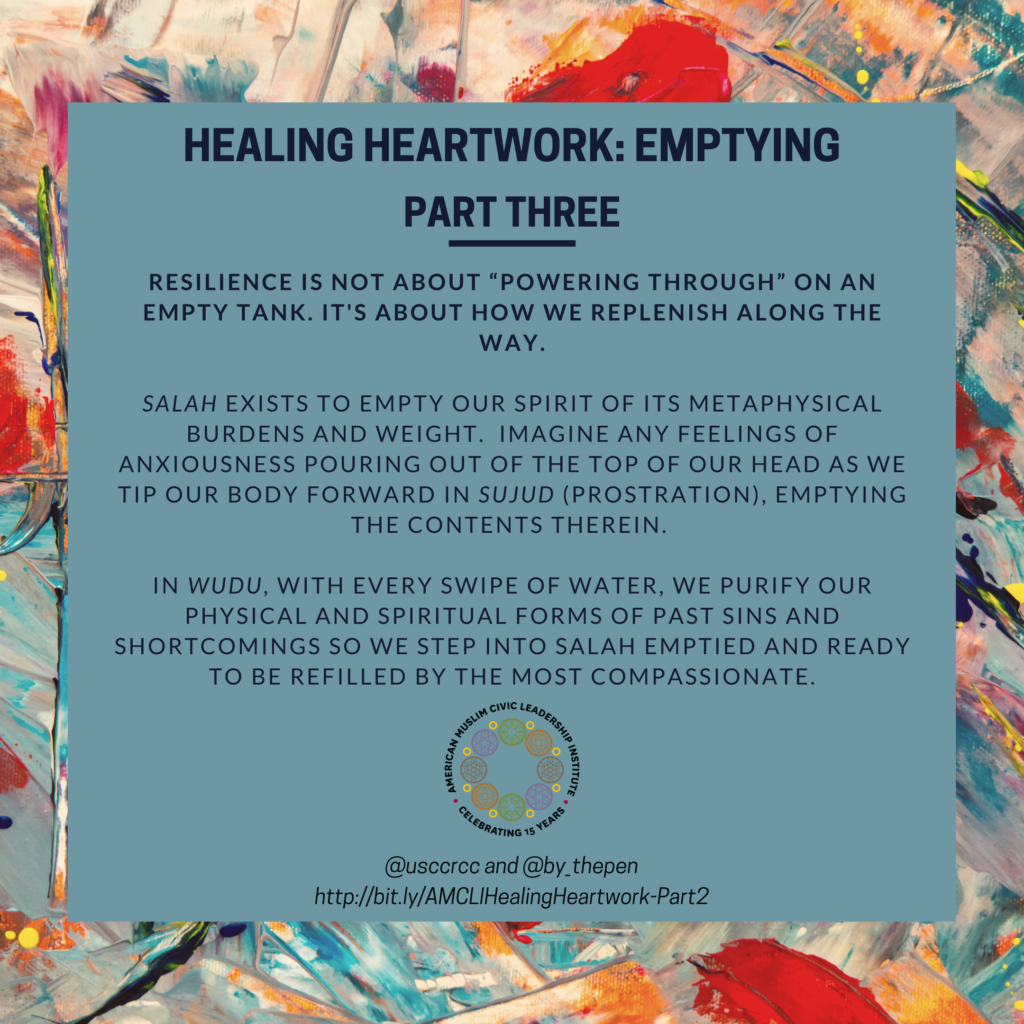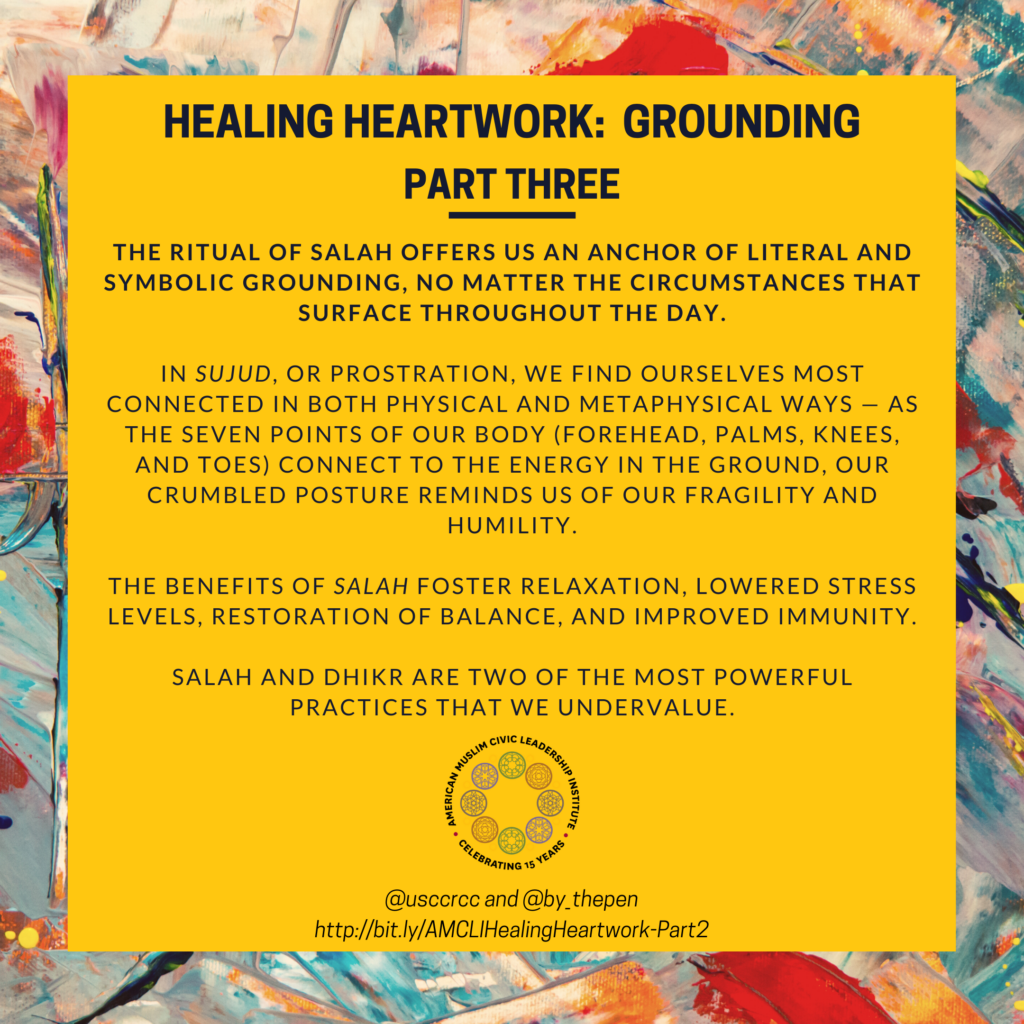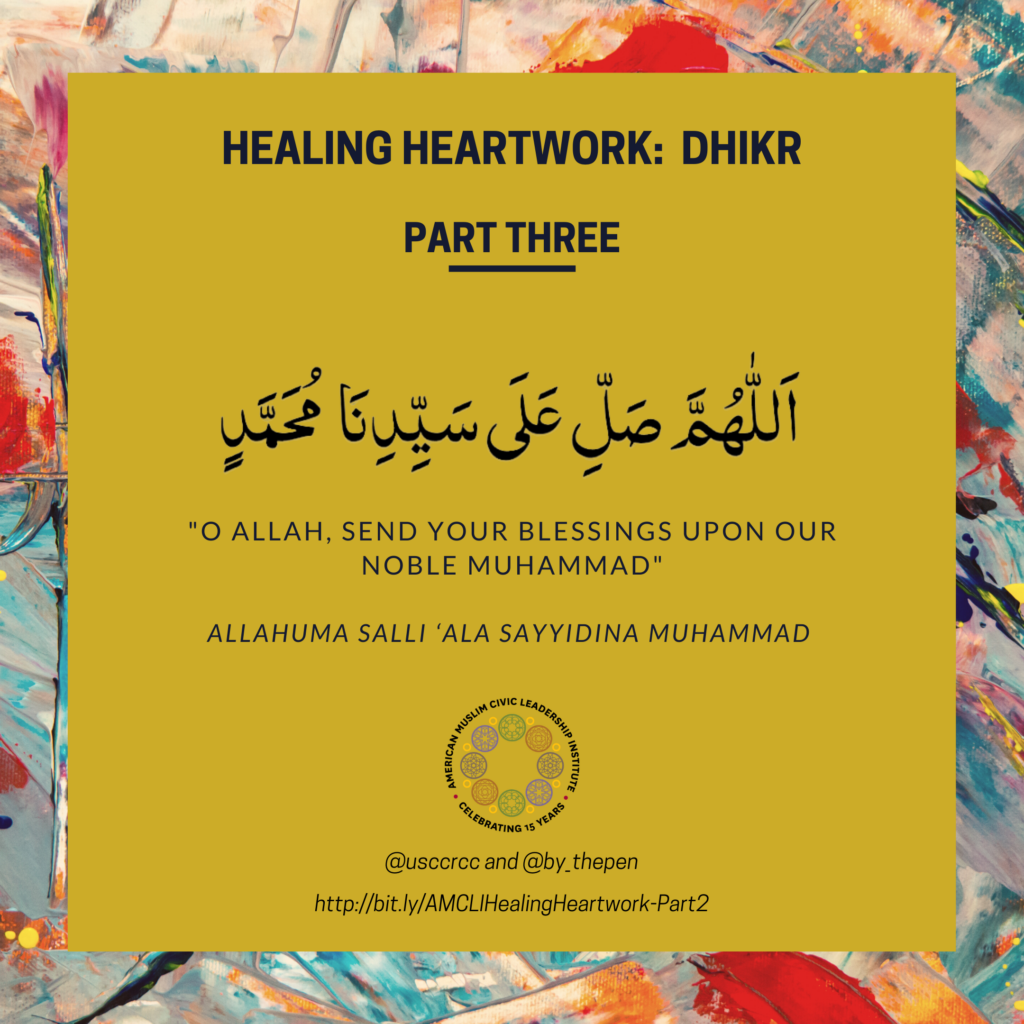Resilience is not about “powering through” on an empty tank; resilience is about how we replenish along the way.
The Arabic word sakinah, or comfort and serenity, connects to the word sakan, which translates to home, shelter, or refuge — a safe space we seek to return to day after day to rest. In these waning hours of the final ten days of Ramadan, and in anticipation of seeking the most blessed Night of Decree in these odd nights, let us consider two practices in which to cultivate moments wherein God may send sakinah to our heart, our spiritual sakan.
The practices of salah and dhikr may serve as our daily replenishment and refuge from this world’s myriad storms as well as augment our healing process. A fascinating connection exists between the clinically proven techniques for healing and our tradition’s main practices of salah and dhikr.
Trauma research identifies specific methods that facilitate healing such as exposure to melody and music, engaging in synchronization of a group in community, performing an act of repetitive somatic rhythm, and incorporating physical movement that links the mind and body.
In salah, we benefit from all of the above methods in this one main ritual, from the melodious Qur’anic recitation (encouraged to be recited beautifully), to the synchronized movement of jama’a prayer, to the mind-body(-spirit) connection of the mindful bowing and prostrating.
So too, dhikr incorporates all of the above with the additional benefits of patterned breathing (practice, for instance, the dhikr of “la illaha illa Allah” or simply, “Allah” with attention to your inhalation and exhalation) and somatic therapy of the consistent clicking of the smooth beads, one by one, or the therapeutic tapping of the thumb to specific points on the finger. It brings new meaning to the aya, “Truly it is in the remembrance of God that hearts find peace” (Qur’an 13:28).
In the Qur’an, we find yet another connection between salah, dhikr, and sakinah. Allah instructs the Prophet Muhammad ﷺ to pray, or invoke blessings, upon those with repentant hearts (9:103) because “salataka sakanun lahum,” or “your prayers are a comfort for them.”
Just as the Prophet’s ﷺ prayers serve as a comfort for us, sending salawat (prayers and praise upon him ﷺ) provides a healing therapy for anxiety — the Prophet ﷺ told a companion that making constant salawat as his dhikr will result in the removal of worries and forgiveness of sins.
Emptying: Multiple times in the day, at designated and purposeful pauses, the Most Merciful invites us into a space of safety and expanse.
If fasting functions in part to empty and lighten our physical form, salah exists to empty our spirit of its metaphysical burdens and weight.
We may even imagine any feelings of anxiousness pouring out of the top of our head as we tip our body forward in sujud (prostration), emptying the contents therein. When the quiet time for retreat and contemplation exists in limited quantities, salah offers us a consistent space to replenish through the union of body, mind, and spirit by engaging all three dimensions of our being.
Through the ritual of wudu, this theme of emptiness emerges even before we approach the prayer rug. In wudu, with every swipe of water, we purify our physical and spiritual forms of our past sins and shortcomings such that we step into salah emptied and ready to be refilled by The Most Compassionate.
From one prayer time to the next, we meet God with a new hal, or state, because God creates us anew, with fresh needs and experiences, at every moment. Moreover, consider the spatial emptiness that greets us in salah; when facing the qibla, we remain united with our prayerful community through this common direction, but alone, we pray into an expanse. In this emptiness, we discover humility, room to breathe, an openness for possibility, and a reminder of God’s Infinite Presence that surpasses time and space.
Grounding: The ritual of salah offers us an anchor wherein we may find literal and symbolic grounding, no matter the circumstances that surface throughout the day.
Coming into salah, we humbly slip off our shoes and hence connect to our spiritual ancestor, Prophet Musa (as), who was commanded by God to remove his sandals before stepping into sacred dialogue. Barefoot, we reconnect to the ground and its neutralizing electric charge, resulting in lower stress levels — among other health benefits — which explains why our Prophet Muhammad ﷺ encouraged us to walk barefoot from time to time.
In sujud, or prostration, we find ourselves most connected in both physical and metaphysical ways — as the seven points of our body (forehead, palms, knees, and toes) connect to the energy in the ground, our crumbled posture reminds us of our fragility and humility.
Choosing a favorite prayer rug (preferred for its texture, design, or fabric), scenting the rug with incense or essential oils, dedicating a corner to salah, and lighting a candle offer different methods of nurturing this feeling of tranquility. Rather than rush through this beautiful ritual, we may rethink our approach wherein we carve out time to recharge via this intimate conversation with the Most Compassionate, our Protector.
Once, I prepared to join one of my spiritual teachers for salah, but he hesitated and then gently advised that I proceed on my own, explaining, “Some people feel that I take too long in prayer, so I don’t want to burden you with my slow pace.” Knowing my limits, I thanked him and performed the salah by myself. Afterward, I watched my teacher with curiosity. Eyes closed, body relaxed and completely still, he lingered in and savored every movement, aligning his cognitive focus (khushu’) with intentional physical posture, as taught by our beloved Prophet ﷺ when instructing us to stretch into the ruku (bow) such that one could hypothetically balance a full cup of water on one’s back.
This mind-body connection embedded in the ritual of salah only recently emerges as a scientific and research-proven benefit encouraged on a daily basis for our well-being.
The benefits of this practice (salah) foster relaxation, lowered stress levels, restoration of balance, and improved immunity.
Ideally, one would train in this mind-body practice of salah such that one could summon the techniques and benefits therein throughout the day, even when away from the prayer rug. Over the centuries, our Muslim saints and sages have written thousands of musings about the physical and metaphysical benefits of this sole ritual.
Salah and dhikr are two of the most powerful practices that we, regrettably, severely undervalue.
May we continue to learn of the metaphysical and practical benefits of our rituals to embrace the prescription as medicinal and not burdensome. God, the Most Generous, sets us up to succeed by directing us toward what He knows we need.
Suggested duaa for the third set of ten days:
O Allah, protect us from the fire.*
Allahumma Ajirna min-an-naar.
*Whether the fire of Hell or the white-hot fires that meet us in this life, we pray for safety and refuge from them all. Ameen.
Suggested dhikr* for the third set of ten days:
O Allah, send your blessings upon our Noble Muhammad
Allahuma salli ‘ala Sayyidina Muhammad
*On the Day of Judgement, our beloved Prophet ﷺ will serve as our intercessor granting us safety and refuge — by Allah’s permission — from the Fire. It seems most befitting, then, to dedicate our dhikr in these last ten days to abundant praise of the beloved ﷺ.
To download the full infographic for Part Two: Mercy and Compassion, click below:
Chaplain Sondos Kholaki is an AMCLI fellow and guest contributor with the USC Center for Religion and Civic Culture.





